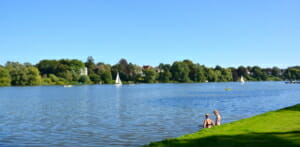PROGEDO presents: The Hanseatic City of Lübeck
Hanseatic City of Lübeck – BASICS … “The Gateway to the North”
Lübeck is located in the North German Plain and, with its 212,000 inhabitants, is one of the most beautiful medieval cities within Germany. Also known as “The Gate to the North” or “The City of the Seven Towers” Lübeck impresses by its close proximity to the Lübeck Ba, as well as to the rivers Trave and Wakenitz and the Elbe-Lübeck canal.
Extensive parks, many green and forest areas, as well as the very unique old town make Lübeck a real eye-catcher, giving the city a unique character and charm. Lübeck is located in Schleswig-Holstein and is the largest commune of the state with a total area of 214.1 km². Lübeck is divided into ten districts with a total of 35 quarters, of which the inner city occupies the smallest.
The old town of Lübeck is located on an island called WERDER and is surrounded by the rivers Trave and Wakenitz. In addition, the Elbe-Lübeck canal crosses the urban area of Krummesse to flow into the Trave. The nearest major cities are the state capital Kiel, located about 78 km northwest, the Free and Hanseatic City of Hamburg, about 65 km southwest, and Schwerin, about 68 km southeast. All three cities can be reached by a very good infrastructure consisting of federal road B76 and motorways A1 and A20 in about an hour’s drive.
Hanseatic City of Lübeck – CLIMATE … simply “maritime”
 Characterised by the so-called “fresh breeze” from the Baltic Sea, the climate in Lübeck is moderately warm – simply maritime. Newcomers should bring a windbreaker, but can also look forward to sunny months. July and August, in particular, are the warmest of the year, with an average temperature of around 17.6° C. The coldest month is January with temperatures just below freezing.
Characterised by the so-called “fresh breeze” from the Baltic Sea, the climate in Lübeck is moderately warm – simply maritime. Newcomers should bring a windbreaker, but can also look forward to sunny months. July and August, in particular, are the warmest of the year, with an average temperature of around 17.6° C. The coldest month is January with temperatures just below freezing.
Hanseatic City of Lübeck – HISTORY and CITY PORTRAIT… “the mother of the Hanse”
Founded in 1143 by Adolf von Schauenburg, Lübeck, as the centre of the medieval Hanseatic League of cities gained much power and wealth. It remained a free imperial city until 1937, but it then felt the consequences of the Second World War. As a reminder, you can still find the bell destroyed by a bomb attack in St. Mary’s Church. The proverbial “Hanseatic sense of citizenry”, however, made it possible to restore and preserve the city architecture erected around 1159 under Henry the Lion. In fact, Lübeck’s Old Town, featuring its famous seven towers, numerous listed buildings, historic alleys, winding alleys, courtyards and monasteries, was declared a UNESCO World Heritage Site in 1987.
Today, Lübeck has Germany’s largest Baltic Sea port, a gateway from the district of Lübeck-Travemünde to countries such as Denmark, Sweden, Finland and the entire Baltic States. There are also numerous ferry connections to the entire Baltic Sea area.
Hanseatic City of Lübeck – ECONOMY … “a continuous process of adaptation”
Lübeck has developed into a centre for trade, services, teaching and research. Dräger, a medical and safety technology manufacturer, medical laboratory-diagnostics company Euroimmun, the marzipan manufacturer I.G. Niederegger, the shipping company Oldendorff or the biotech company G.C. Hahn & Co, the market leader in the area of food stabilizers, all have their headquarters in Lübeck. Since May 2012, Lübeck is considered part of the metro area Hamburg. Lübeck has four public colleges, a large number of high schools and three comprehensive schools.
Hanseatic City of Lübeck – PASTIME ACTIVITIES … “there is much to discover”
Lübeck, the city of poets and thinkers – Lübeck, a city with a lot to offer. For example, walking in the footsteps of Thomas and Heinrich Mann by visiting the world-famous Buddenbrookhaus, or exploring the world of the well-known Nobel laureate author Günter Grass, who made Lübeck his adopted home, and to whom an exhibition centre in the old town of Lübeck was dedicated. Numerous museums for young and old, events in the music and congress hall, as well as the Lübeck theatre also offer a wide range of leisure activities.
And culinary pleasures are also taken care of: gourmets will find a wide variety of first-class restaurants, especially in Lübeck’s old town. Fish lovers and early risers can buy fish right off the boat at Travemünde harbour. Numerous weekly markets expand the range of available fresh produce, and those who like it sweet are right at the Café Niederegger. Here, besides the delicious cakes and aromatic coffee, you will find the well-known Lübeck marzipan in countless variations.
For shopping lovers, Lübeck’s city centre offers a variety of smaller and larger shops, all within close walking distance. From the pedestrian zone ‘Breite Strasse’, where Lübeck’s traditional wine cellar “von Melle” is located, to the famous ‘Hüxstraße’, there are many good shopping possibilities.
Shopping opportunities are further complimented by numerous shopping centres located in the vicinity of Lübeck.
And Lübeck is also for night owls; cosy pubs, cocktail bars or the HÜX, located on the outskirts of Lübeck’s old town, offer a diverse range of evening and night-time activities.
Hanseatic City of Lübeck – PURE NATURE … “relaxation in the green”
If you want to escape the everyday life, the city offers its inhabitants a great variety of tourist attractions and sights, as well as total relaxation in the green. Nature lovers and outdoor enthusiasts definitely won’t be disappointed. Lübeck is one of the largest communal forest owners in the Federal Republic and has nature reserves, numerous hiking trails, extensive park and river landscapes, historic public pools, e.g. the listed river swimming pool at the Falkenwiese, and thus offers a high quality of life. The Baltic Sea region located in the Bay of Lübeck is easy to reach by car within 30 minutes, and the neighbouring state of Mecklenburg-Vorpommern is always worth a trip.


